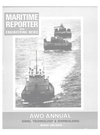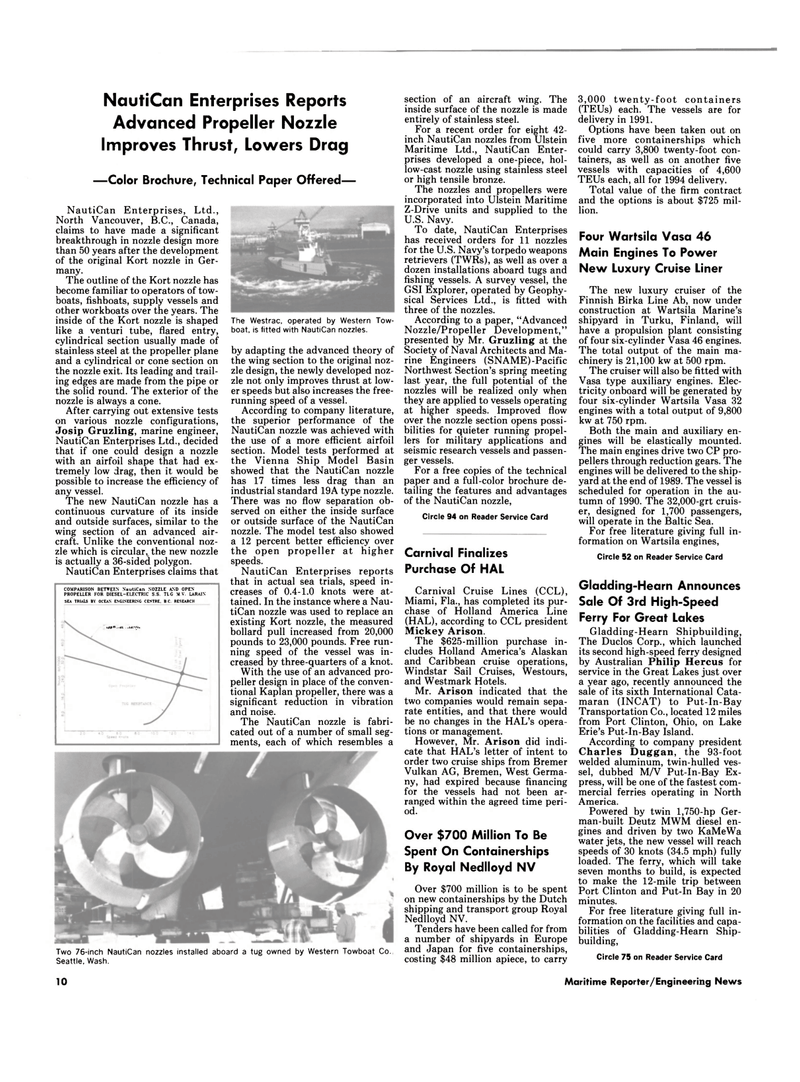
Page 10: of Maritime Reporter Magazine (March 1989)
Read this page in Pdf, Flash or Html5 edition of March 1989 Maritime Reporter Magazine
NautiCan Enterprises Reports
Advanced Propeller Nozzle
Improves Thrust, Lowers Drag —Color Brochure, Technical Paper Offered—
NautiCan Enterprises, Ltd.,
North Vancouver, B.C., Canada, claims to have made a significant breakthrough in nozzle design more than 50 years after the development of the original Kort nozzle in Ger- many.
The outline of the Kort nozzle has become familiar to operators of tow- boats, fishboats, supply vessels and other workboats over the years. The inside of the Kort nozzle is shaped like a venturi tube, flared entry, cylindrical section usually made of stainless steel at the propeller plane and a cylindrical or cone section on the nozzle exit. Its leading and trail- ing edges are made from the pipe or the solid round. The exterior of the nozzle is always a cone.
After carrying out extensive tests on various nozzle configurations,
Josip Gruzling, marine engineer,
NautiCan Enterprises Ltd., decided that if one could design a nozzle with an airfoil shape that had ex- tremely low drag, then it would be possible to increase the efficiency of any vessel.
The new NautiCan nozzle has a continuous curvature of its inside and outside surfaces, similar to the wing section of an advanced air- craft. Unlike the conventional noz- zle which is circular, the new nozzle is actually a 36-sided polygon.
NautiCan Enterprises claims that
The Westrac, operated by Western Tow- boat, is fitted with NautiCan nozzles. by adapting the advanced theory of the wing section to the original noz- zle design, the newly developed noz- zle not only improves thrust at low- er speeds but also increases the free- running speed of a vessel.
According to company literature, the superior performance of the
NautiCan nozzle was achieved with the use of a more efficient airfoil section. Model tests performed at the Vienna Ship Model Basin showed that the NautiCan nozzle has 17 times less drag than an industrial standard 19A type nozzle.
There was no flow separation ob- served on either the inside surface or outside surface of the NautiCan nozzle. The model test also showed a 12 percent better efficiency over the open propeller at higher speeds.
NautiCan Enterprises reports that in actual sea trials, speed in- creases of 0.4-1.0 knots were at- tained. In the instance where a Nau- tiCan nozzle was used to replace an existing Kort nozzle, the measured bollard pull increased from 20,000 pounds to 23,000 pounds. Free run- ning speed of the vessel was in- creased by three-quarters of a knot.
With the use of an advanced pro- peller design in place of the conven- tional Kaplan propeller, there was a significant reduction in vibration and noise.
The NautiCan nozzle is fabri- cated out of a number of small seg- ments, each of which resembles a section of an aircraft wing. The inside surface of the nozzle is made entirely of stainless steel.
For a recent order for eight 42- inch NautiCan nozzles from Ulstein
Maritime Ltd., NautiCan Enter- prises developed a one-piece, hol- low-cast nozzle using stainless steel or high tensile bronze.
The nozzles and propellers were incorporated into Ulstein Maritime
Z-Drive units and supplied to the
U.S. Navy.
To date, NautiCan Enterprises has received orders for 11 nozzles for the U.S. Navy's torpedo weapons retrievers (TWRs), as well as over a dozen installations aboard tugs and fishing vessels. A survey vessel, the
GSI Explorer, operated by Geophy- sical Services Ltd., is fitted with three of the nozzles.
According to a paper, "Advanced
Nozzle/Propeller Development," presented by Mr. Gruzling at the
Society of Naval Architects and Ma- rine Engineers (SNAME)-Pacific
Northwest Section's spring meeting last year, the full potential of the nozzles will be realized only when they are applied to vessels operating at higher speeds. Improved flow over the nozzle section opens possi- bilities for quieter running propel- lers for military applications and seismic research vessels and passen- ger vessels.
For a free copies of the technical paper and a full-color brochure de- tailing the features and advantages of the NautiCan nozzle,
Circle 94 on Reader Service Card
Carnival Finalizes
Purchase Of HAL
Carnival Cruise Lines (CCL),
Miami, Fla., has completed its pur- chase of Holland America Line (HAL), according to CCL president
Mickey Arison.
The $625-million purchase in- cludes Holland America's Alaskan and Caribbean cruise operations,
Windstar Sail Cruises, Westours, and Westmark Hotels.
Mr. Arison indicated that the two companies would remain sepa- rate entities, and that there would be no changes in the HAL's opera- tions or management.
However, Mr. Arison did indi- cate that HAL's letter of intent to order two cruise ships from Bremer
Vulkan AG, Bremen, West Germa- ny, had expired because financing for the vessels had not been ar- ranged within the agreed time peri- od.
Over $700 Million To Be
Spent On Containerships
By Royal Nedlloyd NV
Over $700 million is to be spent on new containerships by the Dutch shipping and transport group Royal
Nedlloyd NV.
Tenders have been called for from a number of shipyards in Europe and Japan for five containerships, costing $48 million apiece, to carry 3,000 twenty-foot containers (TEUs) each. The vessels are for delivery in 1991.
Options have been taken out on five more containerships which could carry 3,800 twenty-foot con- tainers, as well as on another five vessels with capacities of 4,600
TEUs each, all for 1994 delivery.
Total value of the firm contract and the options is about $725 mil- lion.
Four Wartsila Vasa 46
Main Engines To Power
New Luxury Cruise Liner
The new luxury cruiser of the
Finnish Birka Line Ab, now under construction at Wartsila Marine's shipyard in Turku, Finland, will have a propulsion plant consisting of four six-cylinder Vasa 46 engines.
The total output of the main ma- chinery is 21,100 kw at 500 rpm.
The cruiser will also be fitted with
Vasa type auxiliary engines. Elec- tricity onboard will be generated by four six-cylinder Wartsila Vasa 32 engines with a total output of 9,800 kw at 750 rpm.
Both the main and auxiliary en- gines will be elastically mounted.
The main engines drive two CP pro- pellers through reduction gears. The engines will be delivered to the ship- yard at the end of 1989. The vessel is scheduled for operation in the au- tumn of 1990. The 32,000-grt cruis- er, designed for 1,700 passengers, will operate in the Baltic Sea.
For free literature giving full in- formation on Wartsila engines,
Circle 52 on Reader Service Card
Gladding-Hearn Announces
Sale Of 3rd High-Speed
Ferry For Great Lakes
Gladding-Hearn Shipbuilding,
The Duclos Corp., which launched its second high-speed ferry designed by Australian Philip Hercus for service in the Great Lakes just over a year ago, recently announced the sale of its sixth International Cata- maran (INCAT) to Put-In-Bay
Transportation Co., located 12 miles from Port Clinton, Ohio, on Lake
Erie's Put-In-Bay Island.
According to company president
Charles Duggan, the 93-foot welded aluminum, twin-hulled ves- sel, dubbed M/V Put-In-Bay Ex- press, will be one of the fastest com- mercial ferries operating in North
America.
Powered by twin 1,750-hp Ger- man-built Deutz MWM diesel en- gines and driven by two KaMeWa water jets, the new vessel will reach speeds of 30 knots (34.5 mph) fully loaded. The ferry, which will take seven months to build, is expected to make the 12-mile trip between
Port Clinton and Put-In Bay in 20 minutes.
For free literature giving full in- formation on the facilities and capa- bilities of Gladding-Hearn Ship- building,
Circle 75 on Reader Service Card
COMPARISON BETWEEN NautiCan NOZZLE AND OPEN
PROPELLER FOR DIESEL-ELECTRIC S.S. TLG M.V. LARAIN
SEA TRIALS BY OCEAN ENGINEERING CENTRE. B C RESEARCH urn " • •" *••_<-
Two 76-inch NautiCan nozzles installed aboard a tug owned by Western Towboat Co.
Seattle, Wash. 10 Maritime Reporter/Engineering News

 9
9

 11
11
